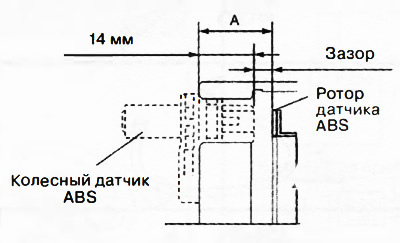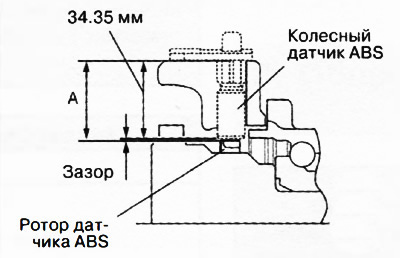Front wheel ABS sensors

1. Connector.
2. Bolt.
3. ABS wheel sensor.
1. Remove mudguard.
2. Disconnect the ABS wheel sensor connector.
3. To turn away a bolt of fastening and to remove the ABS wheel gauge.
4. Installation is made in an order, the return to removal.
5. After installation, make sure that the ABS wheel sensor is not twisted.
Rear wheel ABS sensors

1. Bolt.
2. Rear wheel ABS sensor.
1. Remove the trunk panel.
2. Remove the lining edge of the trunk.
3. Remove the tailgate threshold.
4. Remove the side lining of the trunk.
5. Disconnect the ABS rear wheel sensor connector.
6. Squeeze the bars of the rear ABS wheel sensor and remove the sensor from the outside of the car.

7. Pull off the mudguard and remove the rear wheel ABS sensor by unscrewing the mounting bolt.
8. Installation is made in an order, the return to removal.
9. After installation, make sure that the ABS wheel sensor is not twisted.
Checking the output parameters of the ABS wheel sensor
Attention. Checking the resistance using any testers or ohmmeters can damage the ABS wheel sensor. Use only the M-MDS scan tool to test the ABS wheel sensor output.
1. Turn off the ignition.
2. Connect the M-MDS device to the DLC-2 diagnostic socket.
3. Select the following options:
- WSPD_SEN_LF (left front wheel sensor)
- WSPD_SEN_RF (right front wheel sensor)
- WSPD_SEN_LR (left rear ABS wheel-speed sensor)
- WSPD_SEN_RR (right rear ABS wheel-speed sensor)
4. Start the engine and drive the car.
5. Verify that the M-MDS displays the same speed as the speedometer. If any abnormality is found, replace the corresponding ABS wheel sensor with a new one.
Visual inspection of installed ABS wheel sensor
Check ABS wheel sensors for the following:
- Excessive clearance in ABS wheel sensor
- ABS wheel sensor deformation
- Deformed or damaged ABS wheel sensor rotor
If any defects are found, replace the damaged component with a new one.
Checking the gap in the ABS wheel sensor
Front wheel ABS sensors
1. Remove the ABS wheel sensor from the vehicle.
2. Remove the wheel hub with steering knuckle assembly.
3. Install the ABS wheel sensor on the removed wheel hub with steering knuckle and tighten to 8-10 Nm.

4. Using a set of flat feeler gauges, measure the clearance between the rotor and the ABS sensor.

5. If the measured value is not correct (0.87-1.53mm), check the following parameters and, if necessary, replace the sensor with a new one:
- Deformation or damage to the ABS sensor rotor.
- Deformed or damaged ABS sensor.
- Foreign material on sensor or rotor.
6. Remove the ABS wheel sensor from the wheel hub.
7. Install wheel hub with steering knuckle assembly.
8. Install the ABS wheel sensor.
9. Check the angles of the front wheels of the car.
Rear wheel sensors (2WD front wheel drive versions)
1. Remove the rear ABS wheel sensor.
2. Measure the distance between the mounting surface of the wheel sensor and the rotor. This is size A.

3. Calculate the clearance between the ABS wheel sensor and the rotor using the following formula:
- Gap (mm) = A - 14
4. Make sure that the obtained gap value is correct (0.28-1.17mm). If not, replace the sensor with a new one.
Rear wheel sensors (versions with all-wheel drive 4WD)
1. Remove the ABS wheel sensor.
2. Measure the distance between the mounting surface of the wheel sensor and the rotor. This is size A.

3. Calculate the gap between the ABS wheel sensor using the following formula:
- Gap (mm) = A - 34.35
4. Make sure that the obtained gap value is correct (0.3-1.4mm). If not, replace the sensor with a new one.
